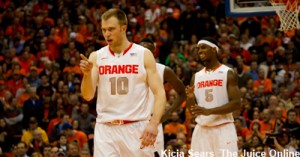
There’s no question that Trevor Cooney had an up-and-down sophomore season. The shooting guard started the season well, hitting 43 of 86 shots from beyond the arc in non-conference play. On seven separate occasions, Cooney hit five or more 3-pointers during the team’s 13 game non-conference schedule.
But we all know that Cooney cooled off once ACC play started. The harbinger came against Miami, when Cooney went an ice-cold 2-12 from downtown, followed up by another 2-12 performance against North Carolina two games later. When it came to playing against ACC teams, Cooney shot just 30.9 percent, and if you take out his 9 for 12 game against Notre Dame, his shooting percentage dipped to 26.6 percent (33-124).

That left Cooney shooting 37 percent from downtown (40 percent overall) on the season, which was still tops on the 2013-14 Syracuse team (Tyler Ennis was second at 35.2 percent). At 12.1 ppg, he was the team’s third leading scorer.
So the question now is: Where does Cooney go from here? While there’s no question that Cooney struggled for the final two months of the season, compared to some of his contemporaries, Cooney is actually far ahead of schedule. And, as past statistics also show, Cooney is in for another marked improvement in his junior and senior seasons.
» Related: Grading the 2013-14 Syracuse basketball season
Consider the following four stat lines:
| Player | FG% | 3P% | PPG |
| 1 | 37 | 25 | 3.9 |
| 2 | 37 | 35 | 7.2 |
| 3 | 43 | 36 | 4.9 |
| 4 | 40 | 37 | 12.1 |
Well, it’s pretty obvious that anyone would take Player No. 4. It should also be fairly obvious that Player No. 4 is Trevor Cooney’s sophomore season. So who are the other three stat lines that appear?
The first is Demetris Nichols. The second is Andy Rautins. The third is James Southerland. All of these stat lines come from their sophomore years. I picked these three players because they were the last three players to be recruited as sharpshooters. It doesn’t hurt that all three had cups of coffee in the NBA.
Well, Cooney certainly bested all three of his contemporaries, at least, as it relates to his sophomore season. Anyone looking at the four players in their sophomore years would almost certainly take Cooney’s 2013-14 season.
The good news for Cooney is that all three of these players showed improvement in their junior seasons.
| Player | FG% | 3P% | PPG |
| Demetris Nichols | 42 | 36 | 13.3 |
| Andy Rautins | 38 | 36 | 10.5 |
| James Southerland | 46 | 33 | 6.8 |
While Southerland’s improvement was more modest, Rautins had a big jump in points. But clearly, the player who had the best improvement and the best overall junior year here is Nichols. And even then, Cooney’s sophomore stats measure up pretty well. If Cooney takes a proportional leap in his junior season, then he could be SU’s leading scorer, depending on the status of Jerami Grant, who is still exploring his NBA draft stock.
» Related: Five things Syracuse needs to do to be successful next year
Looking one more season down the line, it wasn’t until the trio’s senior years that they became stars and consistent contributors.
| Player | FG% | 3P% | PPG |
| Demetris Nichols | 44 | 41 | 18.9 |
| Andy Rautins | 43 | 40 | 12.1 |
| James Southerland | 45 | 39 | 13.3 |
Obviously, these stats are gaudy and impressive. None of the three were considered NBA prospects at the start of their senior season, but by the end, all three had worked their way on to NBA teams. Taken with this lens, Cooney had a better than expected sophomore season. Perhaps we were expecting senior year Cooney to appear in his sophomore year, and that simply isn’t fair to him.
If you take the season as a whole, Cooney ended far ahead of schedule, and this bodes will for his final two years of eligibility.
For more Syracuse coverage, Like our Facebook page and follow us @TheJuiceOnline.

